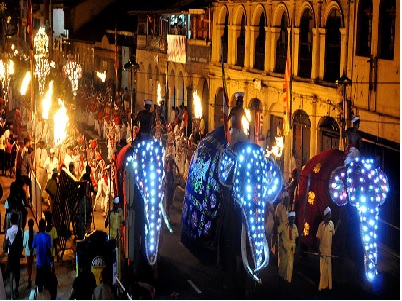
Esala Perahera, one of Sri Lanka’s most vibrant and grandest festivals, is held annually in Kandy. In 2024, the Esala Perahera will take place from July 21 to July 30, promising a captivating display of cultural splendor and spiritual reverence.
Historical Background
The origins of Esala Perahera trace back to ancient times, intertwining with the legend of the Sacred Tooth Relic of the Buddha. According to tradition, the tooth relic was brought to Sri Lanka in the 4th century CE by Princess Hemamali and Prince Dantha. The relic, believed to possess miraculous powers, became a symbol of sovereignty and was enshrined in various locations before finally being housed in the Temple of the Tooth (Sri Dalada Maligawa) in Kandy.
The festival’s roots are linked to the Esala Full Moon Poya Day, marking significant events in the Buddhist calendar, including the Buddha’s conception, renunciation, and first sermon. Over centuries, the Esala Perahera evolved into a grand procession, blending religious ceremonies with elements of Sri Lankan culture and artistry.
Structure of the Perahera
Esala Perahera is a ten-day festival, with each day featuring a series of processions that increase in grandeur and splendor. The event consists of five main processions, each representing a different devalaya (temple) dedicated to various deities:
- Kataragama Devalaya Perahera: Dedicated to the god Kataragama, this procession marks the beginning of the Esala Perahera festivities. It includes traditional dancers, drummers, and elephants adorned with colorful attire.
- Natha Devalaya Perahera: The Natha Devalaya procession follows, featuring dancers, acrobats, and other performers. The Natha Devalaya is associated with the deity Natha, considered a guardian of Buddhism.
- Vishnu Devalaya Perahera: The Vishnu Devalaya procession is dedicated to the god Vishnu, a protector of the island. This procession includes vibrant dancers, musicians, and elephants in elaborate costumes.
- Pattini Devalaya Perahera: Dedicated to the goddess Pattini, the Pattini Devalaya procession is known for its grace and elegance. It features traditional dancers and performers celebrating the goddess’s blessings.
- Randoli Perahera: The final and most magnificent procession, the Randoli Perahera, showcases the Sacred Tooth Relic. The relic is carried in a golden casket atop a beautifully adorned elephant. This grand finale procession is a breathtaking spectacle, with dancers, drummers, and elephants filling the streets of Kandy.
Key Highlights and Rituals
The Kap Situveema (Planting of the Sacred Tree)
The festival begins with the Kap Situveema ceremony, where a young jackfruit tree is ceremonially planted in each of the four devalayas. This ritual symbolizes the commencement of the Esala Perahera and invokes blessings for a successful event. The tree planting is accompanied by traditional chants and offerings.
The Perahera Procession
Each night’s procession starts at the Temple of the Tooth and winds through the streets of Kandy. The Sacred Tooth Relic, enshrined in a golden casket, is carried by a majestic tusker elephant, followed by a retinue of elephants, drummers, dancers, whip crackers, torchbearers, and traditional performers. The rhythmic beats of traditional drums, the vibrant costumes of the dancers, and the intricate designs of the elephants’ attire create a mesmerizing atmosphere.
The Diya Kepeema (Water Cutting Ceremony)
The final ritual of the Esala Perahera is the Diya Kepeema, or Water Cutting Ceremony, held at the Mahaweli River. A priest representing the four devalayas performs the ritual by cutting the water with a sword, symbolizing the purification of the relic and the community. This ceremony concludes the festival, ensuring prosperity and protection for the island.
Cultural Significance
Esala Perahera is not just a religious event but also a cultural showcase that reflects Sri Lanka’s artistic heritage. The traditional dances, music, and costumes displayed during the processions highlight the island’s rich cultural diversity. The festival also fosters a sense of unity and community, as people from various regions and backgrounds come together to celebrate and pay homage to the Sacred Tooth Relic.
Modern-day Esala Perahera
In contemporary times, Esala Perahera has become a major tourist attraction, drawing visitors from around the world. The festival’s organizers ensure that the traditional rituals and customs are preserved while also incorporating modern elements to enhance the spectacle. Efforts are made to provide a safe and enjoyable experience for both participants and spectators.
The Kandy Esala Perahera Committee, along with local authorities, oversees the event’s organization, ensuring that the festival runs smoothly. Security measures are implemented to manage the large crowds, and facilities are provided for the convenience of visitors.
Preparations and Participation
Preparation for the Esala Perahera begins months in advance, involving meticulous planning and coordination. Artisans, craftsmen, and performers work diligently to create the elaborate costumes, decorations, and props used in the processions. The elephants, an integral part of the festival, are also given special care and attention.
Participation in the Esala Perahera is considered a great honor. Dancers, drummers, and other performers undergo rigorous training to perfect their skills and contribute to the grandeur of the event. Local communities and devotees also play a crucial role, offering their support and services to ensure the festival’s success.
Impact on Kandy and Sri Lanka
The Esala Perahera has a significant impact on the city of Kandy and the broader Sri Lankan society. Economically, the festival boosts tourism, generating revenue for local businesses and providing employment opportunities. Culturally, it reinforces the importance of preserving traditional arts and customs.
Socially, the Esala Perahera promotes unity and harmony among diverse communities. The festival’s inclusive nature encourages people from different religious and ethnic backgrounds to come together in celebration. It also serves as a platform for educating younger generations about Sri Lanka’s rich cultural heritage and the significance of the Sacred Tooth Relic.
Challenges and Preservation Efforts
Despite its grandeur, the Esala Perahera faces several challenges. The preservation of traditional customs and practices in the face of modernization is a key concern. Efforts are being made to strike a balance between maintaining authenticity and adapting to contemporary needs.
Environmental and ethical considerations regarding the treatment of elephants used in the processions have also garnered attention. Animal welfare organizations advocate for humane practices and the protection of these majestic creatures. The festival organizers have taken steps to ensure the well-being of the elephants, implementing guidelines for their care and management.
Future of Esala Perahera
The future of Esala Perahera lies in its ability to adapt while preserving its core values and traditions. As Sri Lanka continues to evolve, the festival must find ways to resonate with modern audiences while staying true to its historical and cultural roots.
Innovations in technology and media can enhance the festival’s reach and accessibility. Live broadcasts, virtual tours, and social media platforms can provide a global audience with the opportunity to experience the magic of Esala Perahera. Educational initiatives and collaborations with cultural organizations can further promote the festival’s significance and ensure its sustainability for generations to come.
Visit Sri Lanka and witness this wonderful cultural festival. Contact Us Now

